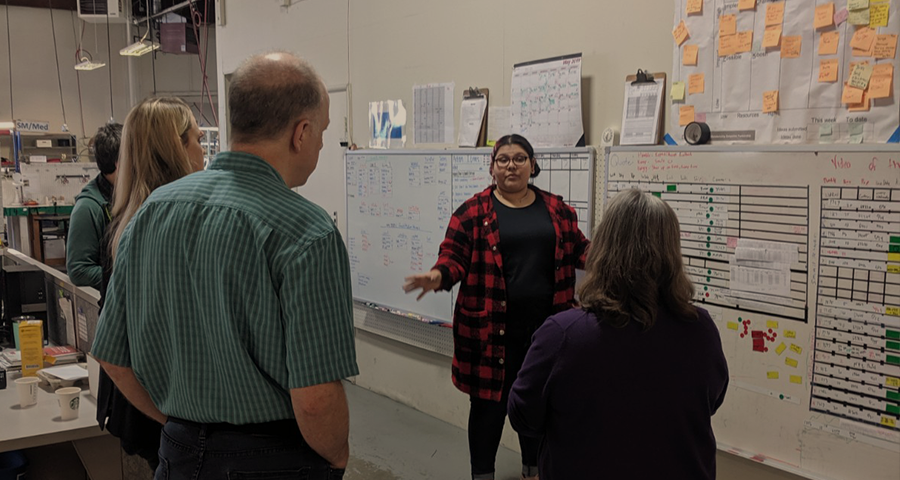As business leaders who are dealing with uncertainty, the ability to remain calm during this time is an opportunity to strengthen your relationships with staff and clients for the long term. During my last webinar I shared my thoughts about leadership during uncertain times, based on my own experience working in manufacturing for 25 years, as well as discussions with manufacturers who have lived through challenges in the past. Here are a few of the takeaways.
KEEP CALM
During a challenging time, there is much outside of your control. However, you can absolutely control your thoughts and behaviors, especially as they relate to interactions with others. A valuable question you can ask yourself every day is, “how am I showing up today?”
As a leader or a peer am I adding to the confusion or bringing calm into the work environment?
Your response has an impact on your work environment and beyond. No matter where you are in the organization (leader, line worker, supervisors) be aware of your impact and ask yourself how you’re showing up.
PRACTICE CLEAR COMMUNICATION AND DECISION MAKING
A manufacturing friend of mine has been through a health situation with many parallels to our current events. In his experience, no one panicked until they lost trust in their lines of communication.
As business owners, we want to maintain a situation where people can trust what they are hearing from us.
Inform your organization about changes with honesty and vulnerability and let people know that this, like many other things, is an ever-changing scenario. Let them know that as the situation continues to develop you will be sharing information with them from trustworthy sources.
ESTABLISH A TEAM AND START EXPERIMENTING
You can establish trustworthy sources and maintain communications by putting together a “war-room” or establishing a group of people from your leadership team that are responsible for sorting through information and discussing the possible consequences and impacts on the business.
You will be very lucky to have 80% certainty about what is happening at any given point in time. This is not unusual. Use your best judgment and frame decision making as an experiment. Tap into the Plan Do Check Act model.
Mistakes and course correction are signs of strength – showing that you are learning and adapting as you go.
FIND AND STAY IN THE PRAGMATIC MIDDLE ZONE
In the news, there are concerns about a potential recession. If this event will be short- or long-term effects, we don’t know. What we do know is that the situation will have a finite duration, which means we need to plan for the future. This is the challenge of dealing with ambiguity and the unknown.
While we don’t know what is going to happen, companies who navigate uncertainty best are organizations whose leadership maintains a pragmatic middle zone. Some people are optimists, others are pessimists.
Reality tends to land somewhere in the middle.
My suggestion is you regularly reflect on where you personally tend to land. Are you overly optimistic or pessimistic? Be aware of your biases. Open a dialog with your leadership team to aim for the middle, and stay aware of your tendencies.
ESTABLISH YOUR ORGANIZATION’S CORE:
If you don’t already have mission, vision, and value statements, now is a great time to establish them. This is important work that can be done easily from remote locations. Your mission vision and values should be conversational, clear, and inspiring. They will guide and align your decision-making process during uncertain times.
PLAN FOR THE FUTURE
In the coming weeks, the landscape will probably shift frequently. Establish a healthy organizational structure, relying on people from different parts of your business for insights as you shift. For example, I like to fish, and I take my drift boat down rivers here in Oregon. Even though I am the one rowing the boat I might be receiving help to navigate things I can’t see from the person sitting in the bow. They can tell me what to do before it’s too late. In the same way, creating and following a well-developed strategy will help you avoid upcoming business challenges.
If your business already has a strategy in place, remember that success in calm water is not the same as success in rapids.
Right now, is the time to be working through contingency and scenario planning. Consider all possibilities and plan for things that may not ever happen. How will you build resiliency right now? Thinking through this as a team helps establish a sense of control.
This event has a finite end. Developing a long-term strategy, preferably documented, and executing against that strategy is key to longevity. Strategies don’t always pay off immediately. Sometimes strategies that don’t seem to be working do need to change, but often they just need more time or slight adjustment.
A good strategy balances and includes top-line strategy, bottom line strategy, and infrastructure strategy. Strategies that don’t include all three put a company at additional risk. Collaboration and data are key to developing and executing a good strategy. A great strategy that isn’t shared throughout an organization does little to contribute to the success of a company.
Develop a strategy, communicate it to your workforce, and align organizational behaviors to support it. Keep your strategy alive, consider it the working document from which you test your assumptions and run tests in the real world. Test your assumptions and validate data to avoid getting caught by surprise.




